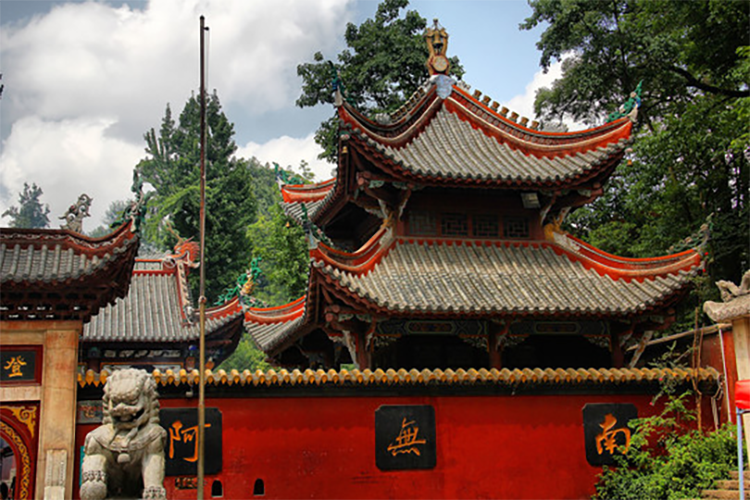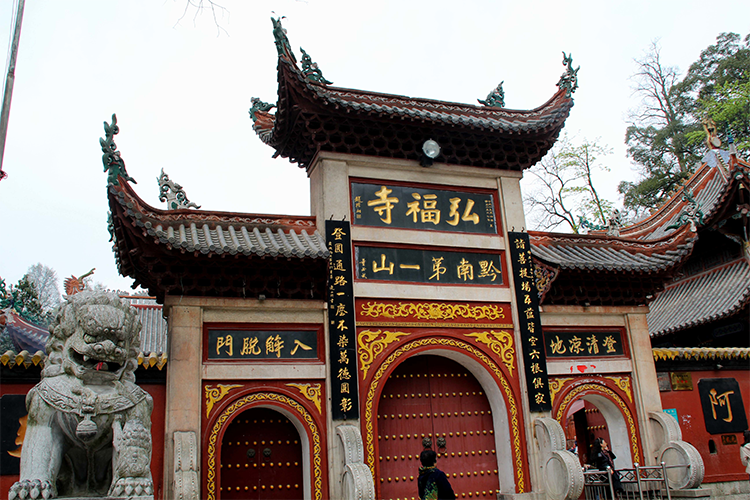Hongfu Temple, Guiyang: Qing Dynasty Temple Architecture & Hidden Zen
Introduction
Early morning on Qianling Mountain still wears a veil of mist when a ribbon of sandalwood smoke drifts up from curving eaves. For 300 years the morning bell at Hongfu Temple has kept the spiritual rhythm of Guiyang—this is Guizhou’s heart of Buddhist culture, a place where Qing dynasty architectural elegance, deep valley landscape and Chan (Zen) wisdom blend into what locals call “the premier mountain monastery of central Guizhou.”
1. The Millennial Seat of Master Chisong: History and Spiritual Core
“One of the best-preserved Qing-era Chan temples on the Yunnan-Guizhou Plateau.”
In 1672 Master Chisong planted the first bodhi tree by hand in this valley ringed by mountains, founding the Linji school lineage of Han Chinese Buddhism in Guizhou. Unlike the orderly complexes of plainland temples, Hongfu embraces a “mountain-temple symbiosis”: buildings step up and stagger along the slope as if a glazed Buddhist realm has risen from the green sea. As a nationally designated key temple, it is both a pilgrimage site and a three-dimensional textbook of Qing dynasty Buddhist architecture.
Cultural resilience through conflict
The stele “Record of Master Chisong’s Deeds” tells of early hardships: monks used local medicinal herbs to treat epidemics, turning the temple into a sanctuary for villagers. During the Cultural Revolution locals cleverly plastered over statues, preserving a Ming bronze bell and a set of eighteen arhats that survive to this day.
2. Architectural Secrets: A Layered Buddhist Celestial Palace
2.1 The central axis as spatial narration
From the mountain gate to the sutra repository, five courtyards rise along a 15-degree incline, symbolically echoing the path of practice—each step like a lotus unfurling. The Mahavira Hall (Daxiong Baodian) features double-eaved xieshan roofs covered in peacock-blue glazed tiles; when sunlight passes the dangling wind-bells at the eaves, moving lotus patterns appear on the ground.
2.2 Artistic treasures you can’t miss
– The subtlety of the Three Buddhas: gilded statues of Sakyamuni, Bhaisajyaguru (Medicine Buddha) and Amitabha inside the main hall use a local “Qian-style gilding” technique that keeps its sheen even in humid conditions. Notice the carved robe folds—artisans mixed purple yingshi stone powder into pigments to create a relief-like texture.
– The bell tower’s secret: a bronze bell cast during the Kangxi reign gives a peculiar “three-tone resonance” when struck. Legend says miners mixed sand from Qianling’s ore into the bell metal.
3. Immersive Zen Experience Guide
3.1 The ritual aesthetics of morning bell and evening drum
At 05:30 each day monks hold morning liturgy in the Guanyin Hall; visitors are welcome to observe quietly. If you arrive on the lunar first or fifteenth day, you may witness the rare Qianling Flower Offering—devotees present wild mountain flowers at the altar, continuing Master Chisong’s tradition of honoring nature.
3.2 A pilgrim’s walking route
Locals recommend this “energy route”: touch the blessing stone at the mountain gate → count the arhats at the Heavenly Kings Hall → circle the main Buddha three clockwise times in the Mahavira Hall → sit quietly behind the sutra library and listen to the pines. Note: the spring beside Guanyin Hall—Dixin Spring (Purifying Spring)—is drinkable; Xu Xiake praised it as “the best water in southern Guizhou.”

4. Practical Information: Respect and Convenience
– Best visiting times: 07:00–09:00 when the morning mist still clings; after 16:00 you can catch monks sweeping leaves in a meditative rhythm. In winter the halls close one hour earlier.
– Dress code: shoulders and knees should be covered; shoes need not be removed. Turn off flash when photographing statues; photography is prohibited inside the sutra library.
– Getting there: Take Guiyang Metro Line 2 to Yan’an West Road Station (Exit D), then the Qianling Mountain shuttle (“Qianling Mountain Line”) to the temple plaza (about 8 minutes). Drivers can park at the foot of the mountain, but parking fills quickly on weekends.
Tickets and services:
– Adult ticket: 20 CNY (includes Qianling Mountain Park entrance)
– English audio guide: 30 CNY for 2 hours (deposit 100 CNY)
– Vegetarian dining: try suantang tofu at Futian Ju (open 11:00–14:00)

5. Further Exploration: Cultural Connections
Combine a visit to Hongfu Temple with these nearby experiences for a perfect day:
– Morning: Zen session at Hongfu Temple → watch wild macaques on Qianling Mountain
– Afternoon: Guizhou Provincial Museum to see artifacts from the Yelang kingdom
– Evening: Jiatlou (Jiaxiu Pavilion) for sunset over the Nanming River
Local tip:
Vendors outside the temple often sell “consecrated amulets.” It’s best to buy ritual items through official temple channels. For a deeper experience, aim for the Buddha Bathing Festival on April 8, when the “thousand-monk meal procession” is most spectacular.
Conclusion
When the city noise is filtered through tiered ridgelines into a backdrop of chanting, you’ll understand why Guiyang people call Qianling Mountain the city’s lungs and Hongfu Temple the window of its soul. Every brick and beam here tells an old covenant between people and nature, faith and daily life—this is more than a sight to see; it is a three-hundred-year conversation waiting to be joined.


